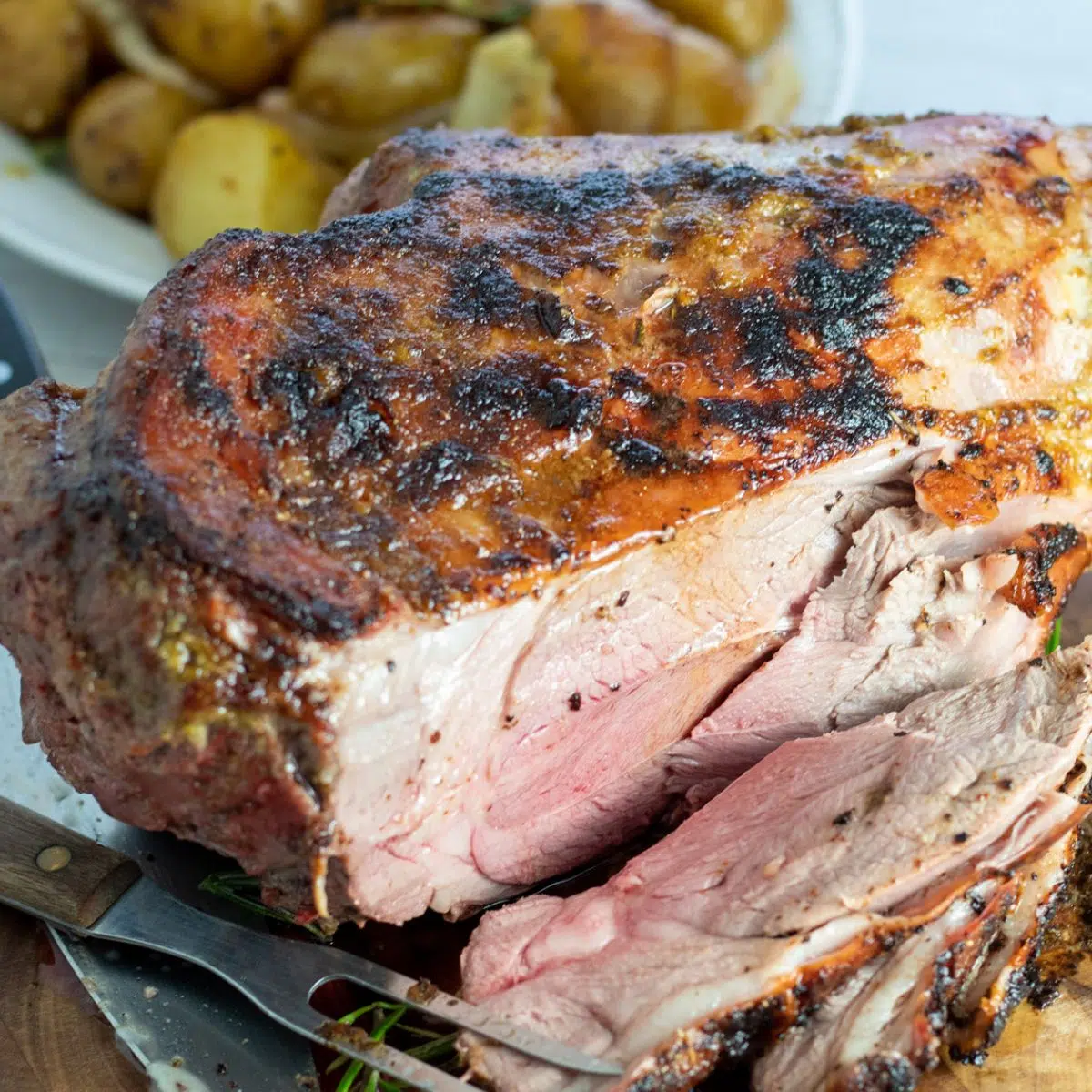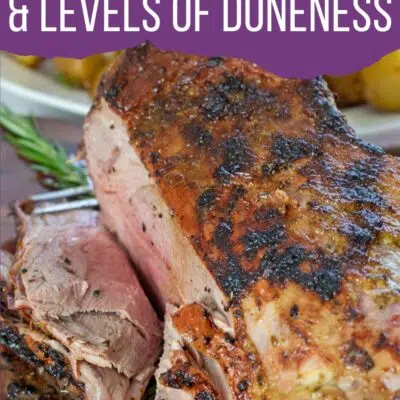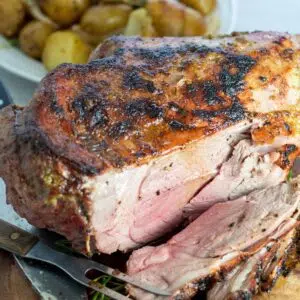Knowing the levels of lamb cooking doneness will help you prepare lamb so that it is perfectly tender and flavorful without being overdone! Take a look at this post to learn the ideal internal temperatures of lamb for achieving the different levels of doneness from rare to well-done. I've also featured useful tips and tricks for roasting lamb, no matter the cut!
Lamb Cooking Temperatures & Doneness
Lamb is a wonderful meat to serve for celebrations. A popular choice for Easter Brunch or Mother's Day, it is important to get the lamb cooked just right! Therefore, knowing the ideal temperatures to reach your desired level of lamb cooking doneness is essential.
Keep reading to find the perfect temperature to cook your lamb, as well as additional roasting tips.

Jump to:
Tips for Roasting Lamb
- Before cooking your lamb take it out of the fridge and let sit on the counter for at least 30 minutes. It may need to sit out a bit shorter or longer depending on the size. The goal is to allow the meat to reach room temperature before cooking.
- Cooking the lamb when it is at room temperature allows for it to cook evenly throughout. When you cook it straight out of the refrigerator it can cook unevenly.
- Season your lamb once it has reached room temperature. Lamb has a naturally rich flavor and doesn't need a lot of extra help. However, a bit of salt and pepper is wonderful to elevate the flavor.
- In addition to a bit of salt and pepper, rosemary is a lovely herb to add to lamb! You can rub fresh or dry rosemary on the lamb with salt and pepper.
- Use a meat thermometer to get the most accurate measurement of doneness. It is difficult to tell how done a piece of lamb is just by looking at the outside (even with smaller cuts).
- Remove the lamb from the oven when the internal temperature is still about 5-10 degrees less than your desired doneness. This is important for step 5 below.
- Let your lamb rest for 15-30 minutes before serving. This allows the juices in the meat to settle and to get the best flavor. Remove from the oven and place on a plate. Cover with tin foil.
- When you allow the meat to sit it will continue to cook from the internal heat. Therefore, to avoid overcooking the lamb it is important to follow step 4 and remove the lamb when it appears to be not quite done.
Lamb Internal Doneness Temperatures
Anytime you are cooking meat it is important to check what the recommended doneness is for each type of meat. While many types of meat have a similar desired level of internal doneness, it does vary between certain types. Therefore, it is important to always double-check.
The USDA is the best place to check the internal temperature of any type of meat should be. Including lamb. Below are the internal temperatures of doneness as provided by the USDA.
- Rare 115-120 °F (46-49°C)
- Medium-Rare 125 °F (52°C)
- Medium 130 °F (54°C)
- Medium-Well 145 °F (63°C)
- Well Done 150 °F (66°C)
The USDA recommends cooking lamb until it is medium-well and has reached an internal temperature of 145 °F. This is the recommendation to safely avoid any food-borne illness.
However, many people prefer to eat lamb that is a bit less done. If you are cooking lamb at home and want to prepare it medium or medium-rare then invest in a quality piece of meat. Consider buying it from a local farm or butcher.
This way you know you are getting a cut of meat that has been properly prepared and processed. Therefore, you are more likely to have meat that can safely be prepared and served below medium-well.
How to Measure the Temperature
The best way to measure the internal temperature of lamb is to use a meat thermometer. A meat thermometer provides a true and accurate measurement of doneness. Therefore, you can easily cook your lamb exactly how you would like.
Moreover, a meat thermometer helps you from overcooking or under-cooking your lamb. However, remember that when you measure the internal temperature look for a lower temperature. 'Carryover cooking' will typically add at least 5°F during the resting time.
For example, if you want to prepare a leg of lamb that is medium-well remove it from the oven when the meat thermometer reads 135-140 °F (57-60°C).
Once you've removed it, cover the roast, and let it sit away from the heat for 15-30 minutes to rest. When you go to serve it, the internal temperature will have risen to about 145°F (63°C).
This provides you with perfect doneness without drying the meat out.
When to Remove the Lamb from the Oven
Here is a quick guide to help you know when to remove the lamb from the oven. Remove the lamb from the oven when it reaches these temperatures. Then, cover the meat and let it rest for at least 15 minutes or until it reaches the desired doneness as listed below.
- Rare: 110°F (43°C)
- Medium-Rare: 115-120°F (46-49°C)
- Medium 120-125 °F (49-52°C)
- Medium-Well 135-140 °F (57-60°C)
- Well Done 140-145 °F (60-63°C)
Choosing the Best Temperature for Roasting
Now that you know the desired doneness you are aiming for, let's look at how to reach it. There are a few general ways to roast lamb.
The first is the low and slow method. Roasting your lamb at a low temperature for a long time. This is typically used for larger cuts of meat.
Another roasting option is to cook the lamb for a shorter amount of time at a higher heat. Typically, this works best for smaller cuts of meat like lamb chops. This method can also be done on a stovetop using a skillet to pan sear your lamb.
The third option is a combination of the two above. It involves quickly cooking the lamb at high heat for a short time to seal in the juices. Then lower the temperature and let it cook slowly.
This is best for larger cuts of meat that are lower in fat (whole leg of lamb, half leg, boneless leg, lamb loin).
Choosing the best roasting method depends on which cut of lamb meat you are cooking. Therefore, there is not one perfect roasting temperature or time for lamb. However, there are some general guidelines.
How Long Does it Take to Roast a Leg of Lamb?
It takes about 30 minutes to roast 1 pound of lamb at 350°F (175°C). Therefore, for a 4-pound leg of lamb plan for about 2 hours of roasting time.
While leg of lamb is the most popular cut of lamb for special occasions, there are several other delicious lamb cuts to choose from. Roasting temperatures and times will vary for each different cut.
For more detailed directions on how to reach the ideal lamb cooking doneness for different cuts of meat, check out my Guide To How To Roast Lamb. This guide has everything you need to get exact roasting times and suggestions for every different cut of lamb!
Did I miss something you'd love to know? Be sure to ask in the comments section below so I can help you perfect your lamb dish!
Do you love a recipe you tried? Please leave a 5-star 🌟rating in the recipe card below and/or a review in the comments section further down the page.
Stay in touch with me through social media @ Pinterest, Facebook, Instagram, or Twitter! Subscribe to the newsletter today (no spam, I promise)! Don't forget to tag me when you try one of my recipes!
📖 Recipe Card
Lamb Cooking Doneness: Roasted Leg of Lamb (+Tips For Lamb Cooking Methods!)
Ingredients
- 5 lb leg of lamb (bone-in, anywhere between 4-7 pounds on average)
- 2 tablespoon olive oil
- salt & pepper
Herb Rub
Roasted Veggies
- 2 cups chicken broth
- 2 lbs yellow potatoes (washed and halved or quartered)
- 1 large onion (sliced in thick rings, or quartered)
- 2 teaspoon garlic (minced)
- 1-2 sprigs rosemary
- 2 bay leaves
- ½ teaspoon each, salt & pepper
- ½ teaspoon garlic powder
- ½ teaspoon onion powder
- ½ teaspoon paprika (optional)
(Note: 2x or 3x only changes the ingredient list)
Instructions
Sear Lamb
- Before starting, set the lamb leg out for 30 minutes to an hour to take the chill off and bring it to room temperature for best results while roasting.
- Rinse and pat the lamb leg dry using paper towels. Trim any excess fat, if needed. Score the upward facing fatty layer in a criss-cross pattern using a (not too sharp) knife without going so deep that you cut into the lamb meat.
- Apply the olive oil and season generously with salt & pepper - use kosher salt & freshly ground black pepper for best taste.
- Place your seasoned lamb into a roasting pan with a rack inside and set your oven to 450°F (232°C). Move the oven rack down if needed, then place the lamb into your oven while it heats. Roast for 8 minutes per side once the oven reaches 450°F (232°C) then remove from the oven.
Make Herb Rub
- While your lamb is roasting, mix the rub ingredients by placing into a food processor or blender. Then, puree or pulse until well combined. Set aside.
Roast Lamb
- Next, reduce the oven temperature to 325°F (163°C) while you allow the lamb to cool enough so that you can apply the rub. Add the broth, potatoes, onion, garlic, rosemary, and bay leaves (remove the roasting rack, if necessary).
- Sprinkle combined seasoning (salt, pepper, garlic powder, onion powder, and paprika if using) over the potatoes before returning the lamb and roasting rack over the veggies.
- Apply the mixed herb rub liberally and generously over the entire surface of the lamb leg, massaging the herbs into all areas of the meat.
- Return the lamb to the oven at the reduced temperature and roast for 25 minutes per pound for medium (with an internal temp of 135-145°F) or until desired doneness (*see note).
- Cover loosely with aluminum foil and rest for 20-30 minutes before serving.
Notes
- Roasting times for different levels of doneness:
- Rare: 15 minutes per pound- internal temp of 125°F (52°C)
- Medium-rare: 20 minutes per pound- internal temp of 130-135°F (55°C-57°C)
- Medium: 25 minutes per pound- internal temp of 135-140°F (57°C-60°C)
- Done/Well Done: 30 minutes per pound- internal temp of 140°F+ (60°C+)
- Fall Off The Bone Tender: 40 minutes per pound- internal temp of 175°F+ (179°C+)
- When buying your lamb, avoid buying mutton. It is an older and tougher type of meat.
- You can ask your butcher to trim the thick layer of fat for you, if desired.
- Resting the lamb is essential in allowing all the juices to redistribute throughout the meat before slicing, do not skip this step.



Comments
No Comments